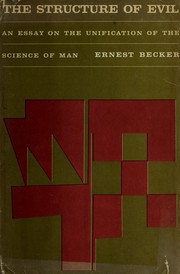Check nearby libraries
Buy this book

The history of the science of man that I draw in these pages is based on the following assumptions, and seeks to support them:
In order to understand the problem of a unified science of man today, we must go back at least to the decline of the medieval cosmology, and to the more or less decisive break from the old order that took the form of the French Enlightenment and, subsequently, the French Revolution. [...]
In the second place, each rereading of history is occupied with "new" facts, even if it uses facts that have been used time and time again. [...]
The specific vantage point that I use for this rereading of history II is a new, unified theory of human behavior. The theory has been very long and very slow in the making, and it is only now that it has become possible to articulate it. This means that my endeavor is a circular one, but I hope a justified, self-reinforcing circularity: a new reading of history that derives from a new theoretical understanding; and a new theoretical understanding that is substantiated by a new reading of history. The circularity, then, is not a "vicious" or sterile one, but rather an incremental one of enhanced logical consistency, and added insight and meaningfulness.
This book, then, is actually the third of a trilogy, which records the development of my ideas and the substantiation of the early perspectives I reached for. In the first work, The Birth and Death of Meaning: A Perspective in Psychiatry and Anthropology, I pulled together an abstract scheme for conceptualizing human behavior, and offered a suggestion for a new orientation for the science of man. The book was directed partly against the ascendancy of medical-psychiatric explanations of human behavior, including Freudian, instinctivist ones. Thus it stressed the largely fictional nature of human meanings, the uniquely linguistic aspects of human experience, and the wholly social-psychological genesis of the self.
In a second work, The Revolution in Psychiatry: The New Understanding of Man, I attempted to fill out this perspective by elaborating comprehensive, social-behavioral theories of mental illness. This second book sought to provide a broader and more detailed explanation of human action and its failures, and to see them as grounded in total, organismic functioning—and not merely in symbolic, linguistic modes. On the one hand, it had to do this without losing the truth of the symbolic approach, specifically, of the social-psychological explanation of the origin and nature of the human self, and how it functions in social interaction. On the other hand, it had to accomplish this total organismic restatement without resorting to the facile reductionist and Freudian-instinctivist explanations of total biological functioning. These two works supplied, I think, the necessary basis for a unified theory of action.
The present, third work, finally, complements the first two, by rounding out and substantiating historically a unified theory of action. Its task is to place the whole understanding of human nature into the historical perspective of the past two centuries, during which time this understanding was gradually being developed. Furthermore, it continues the task begun in the second book, which is to introduce frankly ideas from philosophy and naturalistic descriptive ontology and to attempt to show their indispensable place in a science of man.
The overall result, I dare to hope, is an integral framework for setting in motion a socially experimental science of man—something we have been building for over two centuries.
[From the Preface]
Check nearby libraries
Buy this book

Previews available in: English
Showing 6 featured editions. View all 6 editions?
| Edition | Availability |
|---|---|
|
1
The structure of evil: an essay on the unification of the science of man
1976, Free press
in English
|
zzzz
|
| 2 |
zzzz
Libraries near you:
WorldCat
|
| 3 |
cccc
Libraries near you:
WorldCat
|
|
4
The structure of evil: an essay on the unification of the science of man.
1968, G. Braziller
in English
|
aaaa
Libraries near you:
WorldCat
|
|
5
The structure of evil: an essay on the unification of the science of man.
1968, G. Braziller
in English
|
zzzz
|
| 6 |
cccc
|
Book Details
Edition Notes
Bibliography: p. 405-419.
Classifications
The Physical Object
ID Numbers
Community Reviews (0)
Feedback?History
- Created April 1, 2008
- 10 revisions
Wikipedia citation
×CloseCopy and paste this code into your Wikipedia page. Need help?
| August 10, 2024 | Edited by MARC Bot | import existing book |
| December 11, 2022 | Edited by MARC Bot | import existing book |
| November 10, 2022 | Edited by MARC Bot | import existing book |
| October 5, 2020 | Edited by MARC Bot | import existing book |
| April 1, 2008 | Created by an anonymous user | Imported from Scriblio MARC record |













